Climate-smart agriculture, solution to climate change—Experts
Climate-smart agriculture is one of the reliable solutions to climate change, an agricultural expert and a farmers representative have said.
Speaking during an interaction with journalists on the sidelines of the seventh Climate Change and Development in Africa (CCDA-VII) conference underway in Nairobi, International Research Institute (IRI) participatory researcher John Recha, said across Africa global warming is taking place at a higher rate than previously thought and urgent appropriate action should be taken.

According to the Intergovernmental Panel on Climate Change (IPCC) 2018 report released this week the world is “already seeing the consequences of one degrees celcius of global warming through more extreme weather, rising sea levels and diminishing Arctic sea ice, among other changes.”
Recha told the journalists that changes in rainfall patterns result in harvest losses.
“Failure to plant in the first week of the rainy season means 20 to 30 percent of the yield is lost. The soil loses its nutrients through leaching,” he said.
In an interview, Justus Lavi Kenya, national general secretary for Small Scale Farmers Forum (KESSFF), a grassroots village-based network of smallholder farmers, said farmers in the country are mostly affected by droughts and floods.
“Small scale farming is rain-fed dependent. Whenever there are droughts, small scale farmers are in trouble. When there are floods, small scale farmers are in trouble again. In arid and semi-arid areas of East Africa, during the ripening time of crops when they need water badly, there is no water,” he said.
Currently, CGIAR formerly known as Consultative Group for International Agricultural Research—a global partnership of organisations that research for a food secured future—is working with farmers in some parts of Africa, including Malawi to empower farmers with agricultural climate change adaptation innovations for increased yield output.





